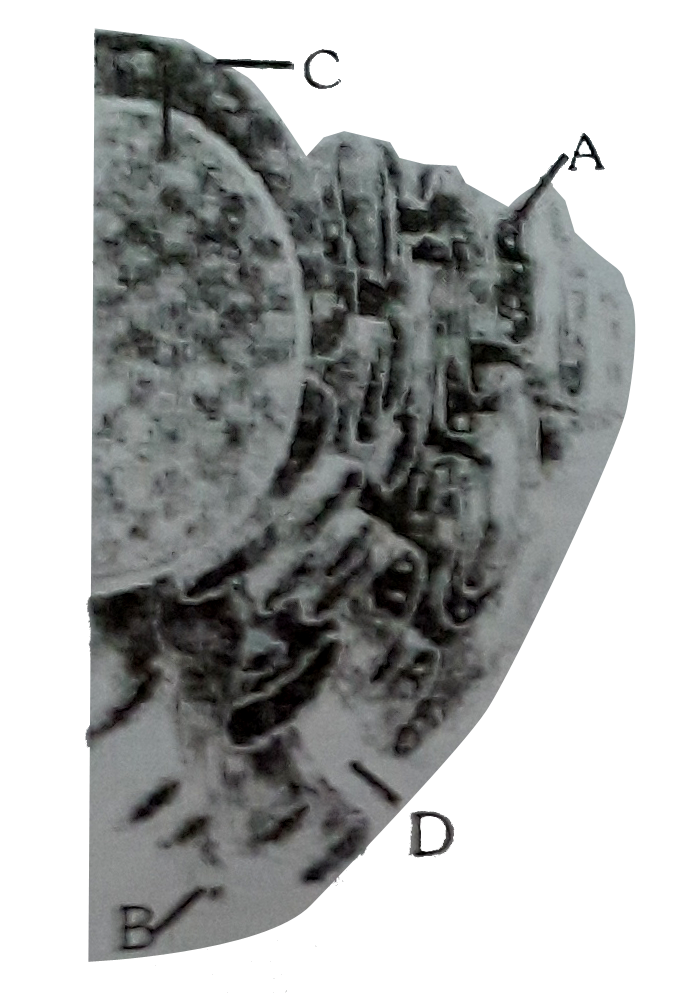Give scientific terms for the following :
(a) Cluster of ribosomes in cytoplasm.
(b) Infoldings of inner membrane of mitochondria.
(c) Stacks of thylakoids in chloroplast.
(d) Stalked particles on the inner membrance of mitochondria.
Step-by-Step Text Solution:
1. Cluster of ribosomes in cytoplasm:
- In the cytoplasm, when ribosomes are found in clusters, they are referred to as Polyribosomes. Polyribosomes are essential for protein synthesis as they allow multiple ribosomes to translate a single mRNA strand simultaneously, increasing the efficiency of protein production.
2. Infoldings of inner membrane of mitochondria:
- The inner membrane of mitochondria has infoldings that increase the surface area for biochemical reactions. These infoldings are known as Cristae. The cristae play a crucial role in the electron transport chain and ATP production.
3. Stacks of thylakoids in chloroplast:
- In chloroplasts, the thylakoids are organized into stacks, which are called Grana (singular: granum). Grana are essential for the light-dependent reactions of photosynthesis, where chlorophyll captures light energy.
4. Stalked particles on the inner membrane of mitochondria:
- The stalked particles found on the inner membrane of mitochondria are referred to as Oxysomes (or ATP synthase complexes). These structures are vital for the synthesis of ATP, the energy currency of the cell, during oxidative phosphorylation.
- In the cytoplasm, when ribosomes are found in clusters, they are referred to as Polyribosomes. Polyribosomes are essential for protein synthesis as they allow multiple ribosomes to translate a single mRNA strand simultaneously, increasing the efficiency of protein production.
- The inner membrane of mitochondria has infoldings that increase the surface area for biochemical reactions. These infoldings are known as Cristae. The cristae play a crucial role in the electron transport chain and ATP production.
- In chloroplasts, the thylakoids are organized into stacks, which are called Grana (singular: granum). Grana are essential for the light-dependent reactions of photosynthesis, where chlorophyll captures light energy.
- The stalked particles found on the inner membrane of mitochondria are referred to as Oxysomes (or ATP synthase complexes). These structures are vital for the synthesis of ATP, the energy currency of the cell, during oxidative phosphorylation.
Topper's Solved these Questions
- CELL : THE UNIT OF LIFE BOOK - PRADEEPCHAPTER - CELL : THE UNIT OF LIFE EXERCISE - ADDITIONAL QUESTIONS (LONG ANSWER QUESTIONS )
66 Videos
- CELL : THE UNIT OF LIFE BOOK - PRADEEPCHAPTER - CELL : THE UNIT OF LIFE EXERCISE - ANALYTICAL QUESTIONS WITH ANSWERS
20 Videos
- CELL : THE UNIT OF LIFE BOOK - PRADEEPCHAPTER - CELL : THE UNIT OF LIFE EXERCISE - ADDITIONAL QUESTIONS (VERY SHORT ANSWER QUESTIONS)
107 Videos
- BREATHING AND EXCHANGE OF GASES BOOK - PRADEEPCHAPTER - BREATHING AND EXCHANGE OF GASES EXERCISE - NOTABLE QUESTIONS
1 Video
- CELL CYCLE AND CELL DIVISION BOOK - PRADEEPCHAPTER - CELL CYCLE AND CELL DIVISION EXERCISE - Assertion-Reason type questions
18 Videos
Similar Questions
Knowledge Check
Infolding from the inner membrane of mitochondria is called
ACristaeBCistrneaCOxyosomesDMatrixThe inner membrane of the mitochondria is usually higly convoluted, forming a series of infoldings Known as
AThylakoidsBLamellaeCCristaeDGranaAssertion : The content of inner compartment of mitochondria is called matrix.
Reason : The outer membrane forms a number of infoldings called cristae.AIf both assertion and reason are true amnd reason is the correct explanation of assertion.BIf both assertion and reason are true but reason is not the correct explanation of assertion.CIf assertion is true but reason is false.DIf both assertion and reason are false.
Give scientific terms for the following :
(a) True internal body cavity of animals
(b) A solid, unjointed rod present in chordates at some stage of life.
(c) Creeping vertebrates.
(d) Pore-bearing animals
View SolutionDouble membrane is absent in
(a) nucleus (b) mitochondria (c ) chloroplast (d) lysosomes
View SolutionThe inner membranes of mitochondria and chloroplasts have ATPase enzymes atached to one face only and contain molecules of the electron transport system.
View SolutionMatch the following
(a) Cristae(i) Flate membranous sacs in stroma(b) Cisternae(ii) Ifoldings in mitochondria(c) Thylakoids(iii) Disc-shaped sacs in Golgi apparatus
View SolutionIdentify the components labelled A, B, C and D in the diagram below from the list (i) to (vii) given along with
Components :
(i) Cristae of mitochondria
(ii) Inner membrane of mitochondria
(iii) Cytoplasm
(iv) Smooth endoplasmic reticulum
(v) Rough endoplasmic
(vi) Mitochondrial matrix
(vii) Cell vacuole
(viii) Nucleus
The correct components are

View Solution